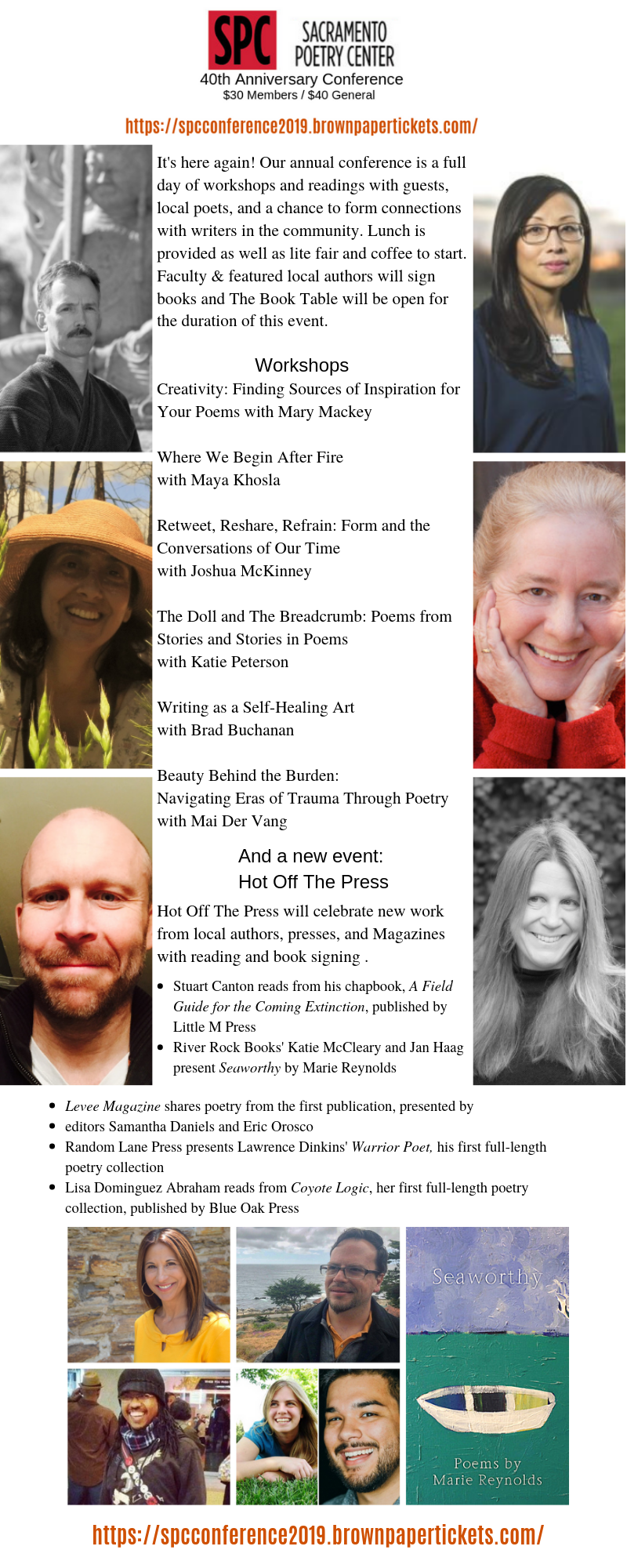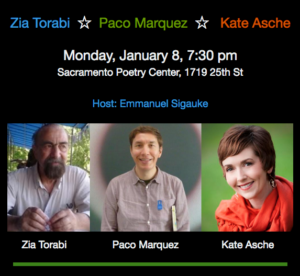The Napa Valley Writers’ Conference of July 2017 was a fantastic six days of writing, learning, and working (and yes, drinking wine!) in community with dozens of amazing writers. Here, I share a bit of the participant experience, including notes from the poetry craft talks (many of which will be relevant to all genres) and from my time working with Jane Hirshfield. Enjoy! ~Kate
**
Sunday, July 23
Hello, Friend!
I left Sacramento at noon today, and my car said it was already 102 degrees and climbing! What a relief that I get to beat this heat—and leave behind and incredibly exciting but also stressful season of change and opportunity at my day job—and give myself this gift of deep time with my writing practice and with other practitioners. I know you, too, experience how challenging it is to disengage from commitments, from central relationships (my wonderfully supportive husband, a full-time student right now, will fend for himself to give me this time) and even from healthful habits (bye bye, running and yoga, this week!) to give yourself dedicated space-time for intensive creation. So I don’t have to tell you that I’m pretty burned out from all the preparation needed to get myself here, and I’m feeling amped up: partly anxious, partly excited, partly exhausted.
My first stop as I drove north up the Napa Valley was my community housing location. As an (extremely) grateful fellowship recipient, I was assigned “a room of my own” in a simple, beautiful home in the hills northwest of Napa. Henni and Lee, my hosts, welcomed me with warmth and interest in poetry and in my particular practice of it, as I gave them a copy of my chapbook and some delicacies from my local farmer’s market—and then moved into their guestroom for the week! (Side note—this year at Napa, a huge percentage of participants received some kind of support, well over half, if my memory serves. That is AMAZING and speaks to the incredible community this conference has built over the decades since its founding!)
Next stop was Orientation at the Upper Valley Campus of Napa Valley Community College in Saint Helena. This tiny campus—just a few classrooms, a small library, and a culinary arts building—is the perfect size for the conference. At the orientation, we met and heard a bit from each person on the incredible conference team. We met briefly with our workshop groups, and the poetry workshop participants received a model poem and the first of our daily assignments. Unfortunately, Jane couldn’t join us for the first meeting, as she was still recovering from a bug she picked up on a recent trip, but we looked forward to meeting her in the morning. Then, it was off to the welcome reception and our first glasses of the week’s many delicious wines, followed by the first of our meals prepared at the culinary school. The evening finished off with readings by Ada Limón and Daniel Orozco on the lawn.
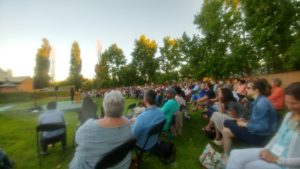
Ada Limon in the opening night reading.
I arrived back at my homestay around 10:00 p.m. My hosts had recently returned from a dinner party and we talked a bit about our evenings and a little more about poetry—and then I finally sat down to do my homework! This room, formerly belonging to my hosts’ daughter, is made for a writer. It contains an amazingly comfortable bed, a sturdy chair, a big white desk fitted perfectly into its nook, and excellent lighting. I set up my laptop and printer (I brought my own, because poetry workshops have a hard manuscript deadline of 8:55 a.m. each morning, and I don’t want to have to wait in line at the computer lab) and got to work.
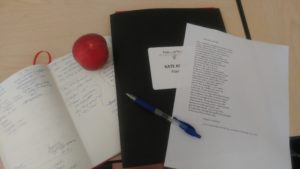
A peach, a poem and a prompt–day one homework!
I came to Napa with a few different poem ideas in mind, and the first daily prompt connected to one of these, so I got to work drafting an occasional poem about the closing of Tomich Orchards in Orangevale, CA, where I’ve bought stone fruit and figs for seventeen summers of the 120 they’ve been around. It’s 1:00 a.m. now, and I had something that looks poem-y enough, so I’m calling it a day and collapsing into bed. Thankfully, the hills around my homestay are quiet, save the occasional crunching of leaves by deer as they make their way from yard to yard, munching in the dark.
Farewell for now,
Kate
**
Monday, July 24
Dear One,
Morning comes earlier here than it does back home—at 6:30, I got myself up, but was moving so slowly that I had to skip showering (good thing the Napa evening was deliciously cool!). I ate some nectarines, yogurt and muesli I’d brought from home. I *know* I am not a morning person, and I wasn’t sure I’d have time to grab a bite before dropping off my manuscript at 8:55 a.m. (for copying for the class) and running to the 9:00 a.m. poetry craft talk. The snacks from home were a good move—I made it to everything, but just in time!
The Napa Valley Writers’ Conference has the wonderful tradition of daily poetry and fiction craft talks. These last one hour and offer a luxuriously detailed glimpse into a particular aspect of craft in each respective genre—and into the particular thinking of each faculty member.
Jane Hirshfield gave the first craft talk of the week, called “It Is Solved by Walking.” I’ll share with you now, in a series of single lines in italics (to indicate my paraphrase of Jane’s words), the moments from this talk that continue to most resonate with me.
The important thing is there be a question whose answer is not simple, direct or single.
To say “I bless” is to bless, is to have blessings to give, for the poem’s duration.
Poems create time and space that their own experience and the reader’s are able to walk through.
Walk, as travel, as path, as simplified intention.
The act of pilgrimages tests faith even as it reaffirms it.
Homeleaving turns the person toward the possible and the accidental.
Art changes the seen to the witnessed.
Jane’s talk, as you can see from the bones of it here, was gorgeous and inspiring! And we walked (Ha! That pun was accidental, and apt!) directly from it into our first class meeting, in which Jane welcomed us and urged us to “Experiment, risk, and surprise yourself with the work of the daily poems. Enjoy your own creative vastness.” Yes, please!
And from that exhilarating exhortation, we jumped into the poems each of us had drafted the night before, hearing each read aloud by its writer, echoing back existing strengths, and then offering questions, confusions and some suggestions, and jotting notes all the while.
One note I made was from a classmate, who shared her practice of keeping a “word palette”—lists of words that she likes, for various reasons (sound, visual appeal on the page, etc.). This practice allows her to see how her tastes, interests and obsessions evolve over time. This idea seems fascinating to me. It’s something I’ve done in my head (the lists, therefore, being very short!) for years, but the idea of writing it down never occurred to me. I want to try it!
Jane created an extremely supportive yet rigorous workshop space from the start. It was fantastic! At the end of todays’ class, we received an intricate prompt involving a series of self-generated lists, with the rule that we must write a poem that includes one item from each of the thirteen lists—yikes! I left class feeling pretty intimidated. I’d already written the poem I’d felt burning hottest inside me. Where would I find the same energy for another, so soon?
From class, we all made our way across the courtyard to the culinary school, where we picked up our plated lunches, and then seated ourselves with new workshop friends. Lunch gets eaten pretty quickly at Napa, because many participants in both genres try to make the fiction panels, too, and these follow immediately after lunch. I decided before arriving that I would not try to make these panels. I have learned in the last few years that I need to protect my time for sleep, so I committed to skipping the fiction panels (which I hear are excellent) to make time for socializing and working on my poems.
After lunch ended, I looked around, hoping to find folks to join in conversation, but the courtyard and lawn were empty! At first, the very extroverted part of me was disappointed. I wanted to make friends and network! With no one to talk to—everyone was either at the fiction panel, or holed up somewhere writing tomorrow’s poem or finishing last-minute fiction critiques—and not wanting to waste twenty five minutes driving back to my homestay, just to have to commute back to Saint Helena again for the evening reading, I selected one of the empty, shaded Adirondack chairs at the far end of the lawn. A few other conferees, including Ryan, one of my classmates, sat among them, quietly working. I settled in for an afternoon of writing.
That is, I tried to settle in. It took a few minutes for me to switch gears from my extroverted, networking “conference” self to my more inward, poem-drafting self, but once I had, I began to taste the full flavor of this conference, from the poets’ perspective: Those of us working on the lawn chairs maintained a respectful, collaborative silence. The wifi was intermittent and, thus, another distraction easily eliminated. I turned my phone to silent and dropped it, face down, into my bag. The temperate, breezy afternoon unfurled before me. I wrote.
For three hours, I wrote. And I got a decent draft! It was overtly political (among other things)—a way of being I shy away from in my poems as well as my life, and in which I feel unpracticed. It incorporated the second of three poem ideas I’d brought with me. I felt tired but also very satisfied after writing it—I had risked something, as Jane has asked us to.
I packed up and joined many of the conferees and community members at Gott’s Roadside for the evening’s “Dine and Donate” event, where the food, the milkshakes, the cool breeze and the writerly company made for a golden light-rimmed meal at redwood-stained picnic tables on the deep green lawn.
From Gott’s we ambled across the street to the first of our off-campus readings, in a barrel room at Merryvale Vineyards, one of Napa’s oldest continuously producing wineries. We sipped the very fine wines as we enjoyed readings by Eavan Boland and ZZ Packer.
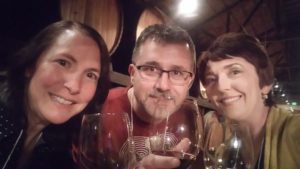
Pre-reading tasting at Merryvale, with workshop-mates Wendy and Ryan.
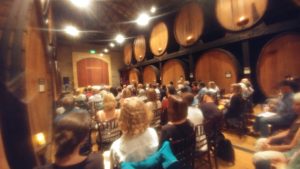
Waaaay down there at the end of the barrel room: Eavan Boland reads at Merryvale.
Once again, I arrived home around 10:00 pm, and this time, I printed my poem, packed my bag for the morning, and went straight to bed!
Buonanotte,
Kate
**
Tuesday, July 25
My Dear Friend,
I awoke feeling pretty good today, which is a major achievement for me when I’m sleeping away from home. (Another reason it’s so hard—and so important—for to make space for experiences like this one, so that I don’t become too afraid of the limits of my body and opt out of the challenges and rewards of intensive experiences like this.)
I’d printed my daily poem before going to sleep, and packed my bag, and I lucked out with a decent hair day, so I skipped showering (again), chatted with my hosts for a few moments over tea and then arrived on campus with time to turn in my poem and enjoy breakfast before gathering for Matthew Zapruder’s craft talk.
Matthew’s talk was super practical. He spoke for about twenty minutes about his own practices, and then provided a series of (often quite elaborate) exercises for generating material.
Some helpful takeaways from Matthew’s talk included the idea that generating material and drafting a poem are sometimes the same thing, but often (for Matthew and many writers) two separate processes. Along with this idea came the idea of getting comfortable with waste. I think a lot of us writers who have many mandatory commitments in our lives—day job(s), partner/spouse, kids, care for elders, health issues, etc. etc. etc.—feel deeply pressured to make every little thing we jot in our notebooks (if we even have notebooks) “good.” Matthews talk went a long way in freeing me from this unhelpful self-pressure and allowing me to get more comfortable with the idea that “wasted” effort—jottings, notes, even full poem drafts that “don’t make it” finally into a poem—is not wasted at all, but is in fact a critical part of the process, and an essential way that we can keep our minds in training, all the time, primed for image, metaphor, symbol and other key forms of association that turn notes into a fully expressed poem. In Matthew’s view, a key strategy for generating lots of material is to work with (sometimes quite elaborate) exercises that over-occupy the conscious mind so that the less conscious, the un-self-conscious, the un-self-critical minds can come out and play.
I left Matthew’s talk inspired to write more and to waste more in my practice. Of course, at Napa, having to generate one poem a day kind of counters this idea of allowing for waste—to me, it feels like there is more pressure here than ever to make every word count! I do hope to try out Matthew’s exercises…at home.
After the craft talk we headed to class and continued to explore each other’s drafts. A key point from Jane in today’s class was that poems need to go beyond the personal. “We want readers’ experiences,” said Jane, “to leap, and not sag, when it comes to ethics. Poems need to take their full moral authority.” Jane also said “When we are wrung by life, we speak truth.”
As class ended today, I actually looked forward to the quiet time that would follow lunch. I sensed this meant I had fully clicked in to the Napa Valley Writers’ Conference culture—and this thought made me smile! Ryan also headed for the Adirondacks after lunch—already, this having become what we do—and along with several of the same few other conferees, we scribbled, stared into space, typed and mumbled to ourselves through the shady afternoon.
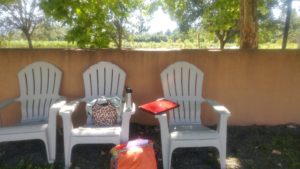
My writing spot for the week.
At 4:00 p.m., Ryan and I packed up and headed down the highway a bit, to Tra Vigne, a fantastic pizza place I’ve had the pleasure of enjoying once before, to meet up with two other classmates, Wendy and Elizabeth. There, we shared a bit more about ourselves and swapped intel on poetry podcasts, other conferences, and on the book projects we’re all at work on.
Tonight’s readings by Jane Hirshfield and Peter Ho Davies were held at Robert Mondavi Winery, a key Napa institution and long-time supporter of the conference. I was delighted to connect with writer-friends from home at the reading: Valerie Fiorvanti and Jen Palmares Meadows came to enjoy the event (Valerie has hosted Peter Ho Davies in several Sacramento literary programs throughout recent years), so I got to catch up with them—so much easier done at the conference than at home, sadly, because we are all so busy! The other fun surprise was the arrival of my friend and mentor, Sacramento Poet Laureate Indigo Moor, a Napa Valley Writers’ Conference alumnus, who was invited to give the introduction for Jane’s reading (and a very fine introduction it was!). Jane’s reading was lovely, including work from her most recent book, The Beauty, as well as new work. Peter’s reading was super strong, too—and quite atmospheric, as the power went out all around the valley for a good twenty minutes of it, and we all created the most wonderfully hushed space in which for him to read, unplugged, as sunset light streamed through the glass ceiling.
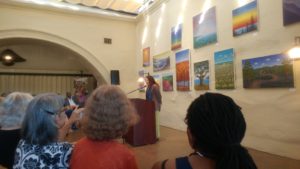
Jane Hirshfield reads from her newest collection of poems, The Beauty, in a truly beautiful place.
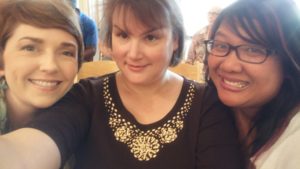
Unexpected company! Valerie Fioravanti and Jen Palmares Meadows came over from Sacramento for the Jane Hirshfield-Peter Ho Davies reading.
And more riches: After the reading ended, Valerie, Jen, and Napa Valley Writers’ Conference Fiction Director Lakin Khan and I met up at a bistro down the highway to enjoy candlelit coffee and dessert, and talk about the news in our lives as writers and people. I first met Lakin though Valerie several years ago, I can’t remember where, and we’ve kept in touch at various Associated Writing Programs (AWP) annual conferences.
And when I arrived home, one of my hosts, Lee, had left a clipping from the New York Times Book Review, a review of Adam Zagajewski’s Slight Exaggeration, with a note on it asking me question about how poems work. I look forward to replying in writing. How delightful to begin this correspondence with my hosts!
What deeply relaxing ways to end a fantastic day!
Er, not quite end it. Because you-know-who still had to print out her poem for the morning. And that, dear one, was my downfall.
Because I’d jumped off my no-caffeine wagon and had a decaf cappuccino, and it had energized me a bit, and because of course I couldn’t print my draft without giving it one last read—and make just this one little nip, which led to a tuck, and pretty soon it was 1:20 a.m. (says the file time stamp on my hard drive, to prove it!) and I was finally printing it, having revised it through four versions *and* become inspired and revised two other existing poems in the meantime.
This, my friend, is what the poetry experience at Napa is all about: diving deeply into your drafting practice, so deeply that you begin encountering answers to questions about other, existing poems you didn’t know you had, and you begin knowing what to do with those answers, and—gift of all gifts—you have the time to go and do it.
So I am going to bed, finally, at 2:00 a.m. I know it will hurt when I wake up—I know it will be a good hurt, a hurt I’ll remember and thirst for, once back in my “real” life.
Ciao for now,
Kate
**
Wednesday, July 26
Hi Again—
Today, I woke up groggy and stiff—from the late hours, and also from doing so much sitting, even more than I do during my normal work-a-day life. Even though I went to bed really late, I set my alarm a bit early and made time for thirty minutes of yoga on the deck at the house. A thin fog still wove through low points in the valley, but on the deck, morning sun warmed my muscles and helped me find more energy.
Once on campus, having just made the manuscript deadline, I beelined for the breakfast buffet, stuffed a couple of pastries in a napkin and shoved them into my bag for later, and then found a seat in Eavan Boland’s craft talk, “Using Images in a Poem.” The talk, which I found quite fascinating, actually was more about using images to build figures than simply creating images. Here are my notes:
According to Eavan, modern poetry has undergone a fundamental shift in speaking consciousness, away from the “we” of the poetry of millennia to the contemporary “I.” She says that when the “we” was lost, the “I” had to begin carrying much more. Eavan believes this shift has affected how images are constructed and used. And here she comes to a point that is quite illuminating for me: Eavan suggests that simile and metaphor are not merely subtypes of the same category (metaphor) differentiated simply by their syntactical construction (the math here is mine: simile = x is like y, whereas metaphor = x is y). Rather, simile is (quoting Eavan here) “an agreed comparison (which can contain contrast) based on shared context that is descriptive of existing meaning.” Historically, Eavan notes, simile comes from epic literature and is “based on the consensus of common sense of what could be perceived, and used to describe the unperceivable.” Metaphor differs, in that it is “a revealed comparison. When we leave the poem, it is gone. It is organic to the situation and revelatory of it. It generates new meaning.” I left the craft talk with a whole new sense of nuance within simile and metaphor, and ready to test these theories in my own work!
From this heady conversation, we went straight to workshop to share our newest poems. I loved the way Jane described strong poems in class today as having “the tension of a flag pulled by wind. Some waysshe suggested we can more our poems into greater tension are by avoiding “thinky grammar” or prose-y-ness, taking mental gestures out, and by removing “damnable expletives” (someone else’s quote, but I didn’t write down whose) like forms of “it is,” i.e. aspects of reality or image that can be contained within stronger verbs and nouns.
As class ended, I texted a longtime friend of mine who lives in Napa, a poet and essayist I don’t get to see much these days. She is busy creating a life of enrichment and exploration for her toddler son, and I am busy supporting my creative practice and my husband’s full time degree work through my jobs. Happily, she and her son were able to meet me on the lawn at campus for a picnic lunch. Between frisbee throws and moments in contemplation of garbage trucks, my friend and I caught up on our lives and literary interests.
But of course, I had more homework to do, so as the visit ended, I found a quiet corner in the library to work on my daily poem, the afternoon having grown warm and my shoulders having grown a bit pink from kid time in the sun. I had arranged to meet classmates for dinner before the evening reading, but I got caught up in my work and left campus later than planned. Traffic was pretty bad, so I ended up grabbing a sandwich for dinner solo. I used this time to complete a thank-you letter to the donors who funded my fellowship (big name people—I was surprised and honored to receive their support).
Soon, it was time to find my way to Pine Ridge Winery, for readings by Matthew Zapruder and Lan Samantha Chang. Pine Ridge was beautiful! A smaller winery (by Napa standards), tucked up against one of Napa’s characteristic tiny hills along Silverado Trail, it boasts an intricate web of wine caves tunneled into the hill. The reading was hosted deep in one of these—with a fault line purportedly visible in the rock of one of the walls! We all said our various prayers at that moment, you bet! It was one of the most dramatic settings for a reading I’ve ever seen, and the readers certainly rose to the occasion.
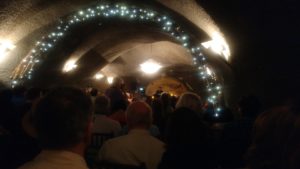
Matthew Zapruder reads in the uber-dramatic wine caves at Pine Ridge.
Another thing I liked about Pine Ridge is that it is five minutes away from my homestay! So I was able to get home quickly and finish another draft for class before it got too late. I wrote a thank-you card to my hosts and then replied to Lee with a note on the Zagajewski book review and propped it on the kitchen table, where he will see it tomorrow morning. And though it’s “only” 11:30 tonight, I am fading fast and ready for sleep.
Until tomorrow,
Kate
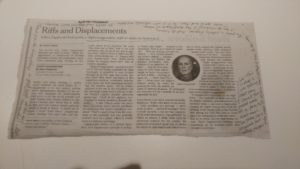
I became pen-pals with my host Lee for the week!
**
Thursday, July 27
Hello, Fellow Word Artist:
As if things could get any better—today is my birthday! And I don’t want to be anywhere else, doing anything else. Contented presence…a wonderful present!
Ada Limón’s craft talk this morning was the last of the four. (I can’t believe this week is almost over already!). Ada’s talk was titled “On Duende and the Ladder: Mystery and Hope in Poetry.” It was fantastic! Even Jane told Ada it was the best talk of the four, and while I am not sure about that—they were all excellent—Ada’s was definitely the clearest, and the perfect tone to end on.
Ada said that “poetry is spoken by a body that is both living and dying.” She wants poems to contain both of these energies. She reviewed Federico García Lorca’s concept of duende, noting that poems containing this energy are aware of death, point earthward/are earthy in their content, embrace the irrational/the magical/surprise, and are driven by some kind of obsession, e.g. the “diabolical” (another of Lorca’s words) and struggle.
Ada went on to pair the duende with the concept of the ladder out, e.g. toward hope. Aspects of the ladder include: the desire for poetry to be a place for radical hope; poetry that acknowledges death while still celebrating life; poetry that practices presence and gratitude; and poetry as a place in which pain transforms. Ada wondered if a lyric poem can offer hope and/or duende without an autobiographical narrative? And finally, can a poem be energized by the duende while also offering hope?
Ada went on to explore these dual/dueling energies through several perfectly illustrative examples by contemporary poets. In one, the idea arose that the act of writing itself can be the ladder’s energy. Of another example, Ada said she’d heard the poet Marie Howe say, “If you want to figure out what your poem’s trying to do, put in the words ‘I want.’” Of another example, Ada noted that writing in form can create something like a duende-esque, “diabolical” struggle with the form itself. Ada ended by suggesting that “sometimes poems fail because we aren’t letting the mess in.”
Ada ended her talk with a list of ways into playing with the duende and the ladder. We all left Ada’s talk totally inspired to duke it out with, and within, our work!
We settled into workshop once again. Today, one of our class poems prompted Jane to give a lovely condensed talk on the haibun form, a Japanese form I play with periodically in my practice that combines both haiku and prose. Jane also spoke about parataxis (the placing of clauses or phrases one after another, without words to indicate coordination or subordination) and how this form of syntax powerfully signals pain, e.g. I can barely say these few words and then must stop.
Class ended, and after lunch, I got to enjoy a key moment of the conference: My one-on-one meeting with Jane Hirshfield. I had brought two questions to ask Jane, and a poem for her to look at.
First, I asked a question that will help me finish the book list for my 2017-18 monthly poetry workshop: What are the best poetry craft and criticism books by women writers?
Jane and I generated this list together: Addonizio and Laux’s The Poet’s Companion (which I read as an undergrad and was so inspired by) and Mary Oliver’s Poetry Handbook, as well as Louise Gluck’s essays Proofs and Theories (I’ve skimmed it an it’s an interesting mishmash of personal essays on the writing life and process plus critical pieces on specific poets), Marianne Moore’s Collected Prose, Virginia Woolf’s essays, Eavan Boland’s two co-written books with Norton (The Making of a Poem, on forms, and The Making of a Sonnet; I have both and like them). Independently, I also discoverd Mary Kinzie’s A Poet’s Guide to Poetry (quite professorial in tone, but very smart and contains some points I haven’t discovered anywhere else). There are also Ellen Bryant Voigt’s The Flexible Lyric, which I personally found hard to connect with, and her Graywolf Art of series contribution, The Art of Syntax, which I find a bit more accessible. An anthology that has some good short pieces by women writers is Beyond Confession. I also like portions of Lyn Hejinian’s The Language of Inquiry.
I also asked Jane who she believes are the most under-read important contemporary women poets. Her response to that includes, in no particular order, Marie Howe, Jean Valentine, Wisława Szymborska, Kay Ryan, Linda Gregg, Linda Gregerson—and with that we got on “Linda” loop including my additions of Linda Bierds as well as Lynda Hull, and then Jane also mentioned Linda Pastan. Jane also mentioned Dorianne Laux as a poet whose work has gone through lots of evolution over time.
Many of these books and authors will make appearances in my 2017-18 poetry workshop!
Then, Jane and I briefly line-edited my day’s draft poem together. It was an amazing learning experience! She helped me see how the poem’s title could do more of the scene-setting work, and how this would allow the poem to start in a more image-oriented, musically rich place. She helped me see how, in places where the rhythm was forced or faltering, the movement of thought also faltered. And she saw right away how much I continued to struggle with the ending, and observed quite correctly that part of this struggle was a sense and syntax I’d arrived at that (totally unconsciously on my part) closely echoed the ending of William Butler Yeats’ “The Second Coming”—a poem I haven’t read in at least a dozen years! It was startling to see how I had so internalized that moment of music that it felt like my own, and how it was this attachment that me down a path to an ending that did not satisfy the demands of the poem. Jane helped me see with greater clarity the moral center of the poem and proposed cuts, changes in rhetorical moves, and even more specific imagery to help drive the poem deeper into its anxiety and questioning. I left elated!
With Jane’s comments still fresh in my mind, I settled one more time into the lawn chairs, and later into the library, to work on my final homework poem of the conference, trying to get it to a place where I could feel comfortable (enough) reading it later tonight, at the open mic. The reading comes with a strict two-minute limit. I timed my poem, and it just fit. Great!
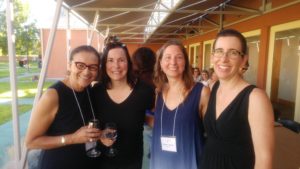
Community night with workshop-mates Peg, Wendy, Elizabeth and Sara.
But first, it was time for the annual Community Night reception and dinner. This annual event brings community housing hosts, donors, former conference staff and other supporters of the program together with the conferees to connect around the literary arts. I was so happy my hosts, Henni and Lee, were able to attend! During the reception, I met many other community members, including a former dean of Napa Valley Community College and her artist husband, and was so impressed by the breadth of the generosity, and the depth of connection, this conference enjoys within the community—and how much it gives back. For example, since the evening readings are open to the public, the conference offers daily talks on that night’s authors at the local library. The Napa Valley chapter of the California Writers’ Club has a table at the conference. And Readers’ Books in Sonoma trucks books all around the valley, to different locations every day, making sure we all can access the very best among the works of the conference faculty and more.
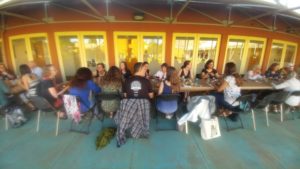
Group dinner with Jane!
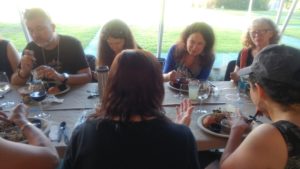
Group dinner with Jane!
At Jane’s request, our workshop group shared dinner together, which was a highlight of the conference for me. It was wonderful to feel the energy of all of us together in a space outside the workshop room, in a different way of relating.
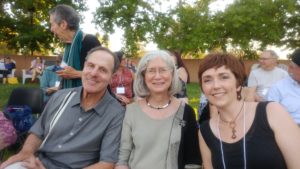
My delightful homestay hosts.
Soon after dinner, the evening’s reading began out on the lawn. Lakin Khan celebrated the end of her tenure as fiction director by reading a delightful smorgasbord of her recent work across genres. Then the open mic began, and I did read the piece I worked on this afternoon with Jane. But because I took a moment beforehand to thank the conference community for a wonderful week—and a perfect birthday!—my poem ran slightly over and I had to rush the end. Drat! Even so, it felt good to read something so rough in front of a huge group of community members, peers and faculty. I haven’t done that in a long time!
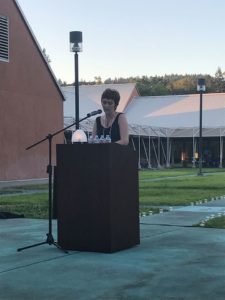
My very own self, reading very fresh, still in-progress work at the open mic.
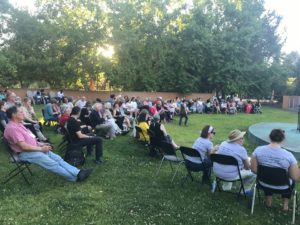
It was a gorgeous night for the community dinner and open mic!
When I arrived home I saw that, Lee, my host, received my reply on the review, and has written me back on a sheet of lined yellow legal paper. I’ll reply tomorrow—I have to finish my final poem of the week first!
So for now, I must bid goodnight,
Kate
**
Friday, July 28
Good Morning, Friend,
I am worn out! In finishing my workshop poem, I again became inspired to revise several more—and decided, since it was the final night, I’d just go for it. I stayed up until almost 2:00! Thankfully, my incredible hosts have agreed to let me come back for my things after the conference ends at lunch time.
I made the 8:55 a.m. deadline the final time (phew!) and attended the poetry first books panel. It was exciting to see Phyllis Meshulam, one of my classmates, featured on the panel for her book that came out the week before the conference! Another panelist, Marcene Gandolfo, is a Sacramento native, and a third, Eric Sneathen, is a fellow UC Davis Creative Writing Program alum. Good times!
From the first books panels, we made our way to our final workshop meeting, where we shared a final round of poems and then enjoyed open Q&A with Jane. Our group then exchanged contact info and shared lunch, and—just like that—it was all over. We hugged and said goodbye and began our drives down the valley.
I made my way back to my homestay, packed my things, and said one more thank you and farewell to Lee, who had just arrived home from a charity golf tournament.
I got in the car and quickly found myself back in my other life, my usual life: sitting in bumper-to-bumper traffic on I-80 in triple digit heat! But I felt inside me more space than I arrived with, and in this space—which felt shady and green, lit by the light of the musing I did on the Adirondack—I found a new level of commitment to my work as poet, both on the page in the world.
Much love,
Kate
**
August 20, 2017
Hello Again, My Friend!
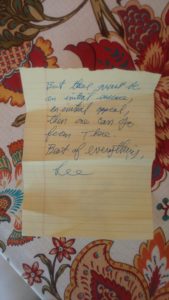
Lee’s reply, part of our impromptu exchange of notes during the week.
It’s been so busy since I returned that I haven’t had a chance to send my final reply to Lee until now. So this post-script, or sorts, is addressed to Lee.
Lee, to your comment that poetry must start from “an initial essence, an initial appeal, and then one can go from there,” my response is: I think we are saying the same thing! For me, the initial essence or appeal is the possibility the writing and reading of poetry afford me to live more deeply. Sometimes a question or situation that continues to hold mystery, longing or pain for me prompts me to write a poem. Sometimes I give myself a prompt or exercise that helps me find my way to such a question or situation through the act of writing. And when I read the work of others, I read to find myself within mysteries I hadn’t conscious known, or known in a particular way. For me, the appeal is in the opportunity to experience more, know more, feel more of what it is to be human here on earth, now and through time. I find that writing and reading toward more and different expressions of what being human is leads me—often against my prideful individual will and in the face of my compelling individual fears!—toward a more humane way of living, which is, for me, another way of saying that poetry leads me toward grace.
This is one of the great paradoxes of art: The further we creators travel inward through our work to find and explore the memories, visions and questions that pursue us, the closer we come to touching the experiences of others. We meet others, and others meet us, in the intimate, communal space our poem, our story, our artwork creates. I can’t remember when exactly this good and oft-made point was offered during the conference (I think it may have been in one of the workshop sessions with Jane, or in comments at one of the poetry craft talks, but I have no notes, only the memory), but it was made: The transformation of personal experience or questioning into art, e.g. a public experience, is always political, and even more so when the transformation occurs in the context of oppression, both overt and denied. Our burden to seek and speak truth is as heavy as ever in this moment.
And with these thoughts, my unforgettable week at Napa truly draws to a close. I look forward to attending again one day!
To all my workshop mates, to the conference staff, to the donors, to my hosts Henni and Lee, and especially to Jane: Thank you for a most exhilarating, challenging, and inspiring week!
Yours in writing,
Kate

